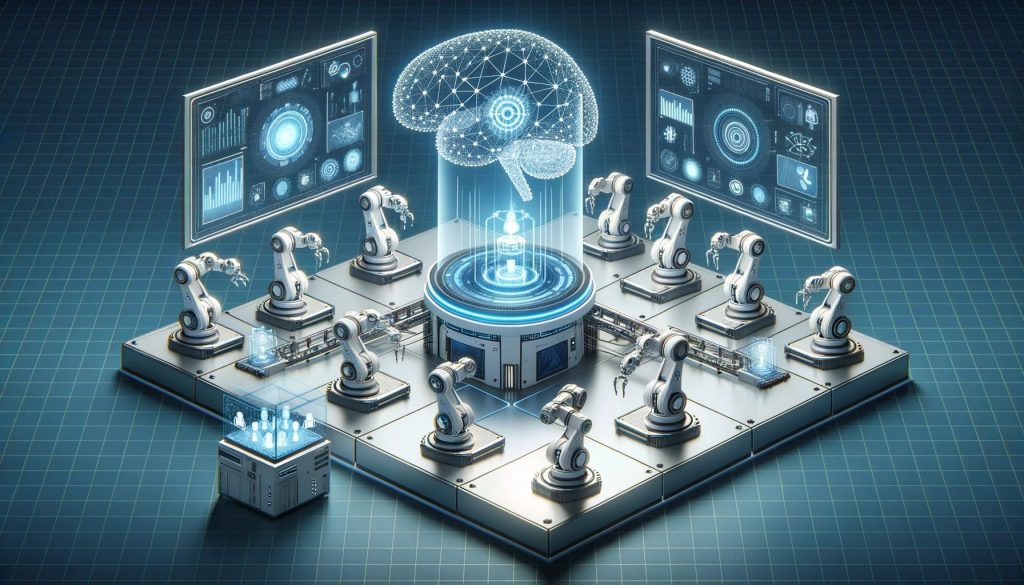Let’s imagine the evolution of machine learning models as the quest for seamless traffic flow amidst increasing vehicular diversity.
Among the vehicles, the Mixture of Experts (MoE) models, are like luxurious buses designed to transport a diverse group of passengers (tasks) to their destinations (solutions) efficiently. Each passenger can find a seat (expert network) tailored to their unique needs, with a sophisticated traffic manager (gating network) ensuring a smooth journey towards their destinations. However, as the fleet expands to accommodate a burgeoning passenger list (increasing diversity of tasks), the highway begins to witness traffic snarls.
The traffic manager, once adept at routing, now faces the Herculean task of navigating through a congested network, leading to computational gridlocks. Enter Sparse Expert Models, the avant-garde traffic systems equipped with intelligent routing algorithms to alleviate the congestion.
Unlike the traditional MoE models, where every passenger had a designated seat, Sparse Expert Models introduce a dynamic seating arrangement. Here, only a select few seats (experts) are occupied based on the current traffic (task) conditions, ensuring an agile and efficient flow on the highway of computational processes.
This not only eases the traffic but also paves the way for scaling the fleet to accommodate an ever-growing passenger list without the dread of gridlocks. This innovative traffic system doesn’t just solve the congestion problem; it opens new lanes of possibilities in the sprawling cityscape of AI/ML.
Sparse Expert Models

The fundamentals of Sparse Expert Models lie in two core properties: Routing Sparsity and Specialized Experts.
Core Properties of Sparse Expert Models
- Routing Sparsity: Selective activation of experts, often termed as routing sparsity, significantly reduces the computational burden, allowing the model to operate efficiently even as the number of experts scales up.
- Specialized Experts: Each expert is designed to handle specific types of tasks or domains, thereby enhancing the accuracy and efficiency of the model.
Consider a Sparse Expert Model deployed in a multilingual translation system. Suppose the model comprises experts specialized in different language pairs. When a translation task from English to French is presented, the model activates only the experts specialized in English-French translation, while keeping the rest inactive. This selective activation ensures that only the relevant expertise is utilized, making the process efficient and accurate.
Benefits
- Computational Efficiency: Sparse Expert Models dramatically reduce the number of Floating-Point Operations Per Second (FLOPs) required to process each task. This reduction in computational requirements translates to faster processing times and lower resource usage.
- Memory Efficiency: Operating sparsely, Sparse Expert Models require less memory for activations and parameters.
- Improved Generalization: With many specialized experts, Sparse Expert Models facilitate the sharing of knowledge across different experts, which can lead to improved generalization on unseen or new tasks.
- Scalability: The sparse activation of experts enables Sparse Expert Models to scale to many experts without a corresponding linear increase in computational and memory requirements.
Major Architectures

Various architectures embody the principles of Sparse Expert Models, each with its unique design and contributions to the field.
- Sparse MoE (Uber AI Labs): Sparse MoE employs a trainable router for the selective activation of experts. This architecture demonstrated how sparsity could be integrated into the MoE framework to achieve computational efficiency while maintaining, or even enhancing, model performance.
Switch Transformers (Google): Switch Transformers improve the router design and introduce advanced training techniques. These innovations have helped achieve state-of-the-art results on various Natural Language Processing (NLP) datasets. - BASE Layers (DeepMind): BASE layers build on the Sparse MoE routing framework to achieve high performance with over 10,000 expert networks. They have significantly pushed the boundaries of what’s possible with Sparse Expert Models.
- Mixture-of-Experts Layers: Integrated into transformer architectures, Mixture-of-Experts Layers are utilized in models like GShard and GLaM.
- Hierarchical MoE (DeepMind): Hierarchical MoE introduces multi-level expert hierarchies to enable massive scaling in models like the Pathways model.
Evaluation Metrics

Evaluating the performance and effectiveness of Sparse Expert Models requires a multifaceted approach, encompassing various metrics that reflect both the computational efficiency and the quality of the solutions provided by these models.
Computational Efficiency:
- Floating Point Operations Per Second (FLOPs): Lower FLOPs indicate better efficiency.
- Execution Time: The time taken to process a given task(s).
Memory Efficiency:
- Memory Footprint: The amount of memory required for storing the model parameters and intermediate activations during execution.
- Parameter Efficiency: Higher parameter efficiency indicates that the model can achieve good performance with fewer parameters.
Improved Generalization:
- Accuracy on Unseen Data: Evaluating model performance on unseen or new data helps in assessing its generalization capability.
- Transfer Learning Performance: The ability of the model to leverage knowledge acquired from one task to perform well on a related but different task.
Scalability:
- Scaling Efficiency: The ability of the model to maintain or improve performance as the number of experts or the size of the model increases.
- Model Size vs Performance: Analyzing the trade-off between the size of the model (number of parameters/experts) and its performance on the task(s) at hand.
Benchmarks:
- Standard Benchmarks: Performance on standard benchmarks in the field (e.g., GLUE, SQuAD for NLP tasks) provides a common ground for comparing Sparse Expert Models with other architectures.
- Real-world Application Performance: Metrics derived from real-world applications, such as translation quality in a multilingual translation system, or the accuracy and speed of object detection in a computer vision system.
Training Sparse Expert Models

The training phase is a critical juncture in the life cycle of Sparse Expert Models, where the groundwork for sparsity and expertise is laid.
Challenges
Credit Assignment Problem: The credit assignment problem is a central challenge in training Sparse Expert Models. It revolves around the task of accurately attributing the contribution of each expert to the outcome, which is pivotal for the learning process.
The crux of the problem lies in the dynamic nature of the gating mechanism, which decides which experts to activate for a given input. The conventional backpropagation algorithm struggles to effectively propagate the error signal through this gating mechanism, leading to insufficient or misdirected gradient information for updating the expert networks and the gating network.
Various strategies have been proposed to tackle the credit assignment problem in Sparse Expert Models. For instance, a dedicated credit assignment module can be introduced, which maintains a record of the contribution of each expert over time.
Capacity Overprovisioning: In the early stages of training, it’s common for many experts to remain unused. This phenomenon, known as capacity overprovisioning, can hinder the learning process as it limits the diversity of the expert responses. Overprovisioning can lead to a waste of computational and memory resources, which is contrary to the core philosophy of Sparse Expert Models.
One common approach to address capacity overprovisioning is to start the training process with a larger number of experts than needed and allow the model to learn and adapt the usage of experts dynamically over time. This way, the model can discover the most effective set of experts to activate for a diverse range of tasks, thereby reducing overprovisioning and enhancing efficiency.
Imbalanced Expert Utilization: The imbalanced utilization of experts is another challenge that stems from the potential biases in the gating mechanism. Some experts might be favored by the gating mechanism and get activated frequently, while others remain largely unused. This imbalance can lead to suboptimal performance as the model fails to leverage the collective expertise of all available experts.
Various techniques have been proposed to address imbalanced expert utilization. For instance, regularization terms can be added to the loss function to encourage a more balanced usage of experts. Additionally, the design of the gating mechanism can be refined to ensure a fairer distribution of the input tasks among the experts.
Regularization Techniques

Router Regularization: The router, responsible for directing input tasks to the appropriate experts, plays a critical role in the performance of Sparse Expert Models. Router regularization techniques aim to enhance the functioning of the router, ensuring balanced and effective utilization of the experts. One common approach is to introduce entropy penalties on the router’s distribution over experts, encouraging a more uniform distribution and thereby, a broader usage of experts.
Noise Injection: Noise injection is a regularization technique aimed at enhancing the robustness and generalization capability of Sparse Expert Models. By adding a small amount of noise to the inputs or outputs of the router, the model is discouraged from overfitting to specific experts. This injected noise creates a form of uncertainty, forcing the model to consider alternative routing decisions and thereby, promoting a more robust and diversified utilization of experts.
Additional Solutions
Expert Load Balancing: Balancing the load among experts is critical for efficient utilization and ensuring that each expert is learning useful representations. Expert Load-balancing techniques are employed to redistribute the tasks among underutilized experts, thereby enhancing both the utilization and the performance of the model. This redistribution can be achieved through various mechanisms, including modifying the gating network to favor underutilized experts or dynamically adjusting the allocation of tasks based on the current utilization rates of the experts.
Auxiliary Losses: Incorporating auxiliary losses can be instrumental in improving credit assignment and overall model performance. Auxiliary losses provide additional training signals that help guide the learning process, ensuring that each expert and the router are learning useful representations and making effective routing decisions. For instance, an auxiliary loss could be designed to penalize the model when it fails to activate an expert who could have provided a better solution for a given task, thereby encouraging better routing decisions.
Parallel Training

Model Parallelism: Sparse Expert Models, with their modular architecture, are naturally suited for parallel training. Model parallelism involves distributing the experts across multiple devices or nodes, allowing each device to handle a portion of the computation. This distribution enables the training of models with many experts, overcoming the memory and computational limitations of a single device. However, the communication overhead between devices can be a bottleneck, and strategies like efficient task allocation and optimized communication protocols are essential for effective parallel training.
Efficient Data Parallelism: Data parallelism involves replicating the entire model across multiple devices, with each device processing a subset of the training data. However, replicating the full model can be resource-intensive, especially for large Sparse Expert Models. Efficient data parallelism strategies, like replicating only the small router network instead of the full model, can significantly reduce the memory and computational requirements, making data parallelism a viable strategy for training large Sparse Expert Models.
Applications of Sparse Expert Models
The realm of Sparse Expert Models is not confined to theoretical exploration; it finds practical applicability across a wide array of domains within AI/ML.
- Natural Language Processing (NLP):
- The advancement in NLP has been remarkable with the advent of large pre-trained models like GPT-3.5/4 by OpenAI, which boasts 175 billion parameters.
- However, DeepMind’s GShard and Google’s GLaM are quintessential examples of how Sparse Expert Models can be leveraged in NLP. GShard, with its capability to handle up to 8 million parameters, showcases how sparse gating and sharded attention mechanisms can significantly improve efficiency and scalability in language models. On the other hand, GLaM (Gated Linear Networks) exemplifies how sparse gating can be utilized to achieve competitive performance on NLP tasks, even with a simpler model architecture.
- Computer Vision:
- Vision Transformer with Mixture-of-Experts (ViT-MoE) by Facebook AI is a laudable endeavor to meld Sparse Expert Models with vision tasks. By integrating MoE layers into the Vision Transformer architecture, ViT-MoE achieves a compelling balance between computational efficiency and performance on image classification benchmarks.
- Google’s venture CoCa (Contrastive Captioners) further emboldens the narrative of Sparse Expert Models in computer vision. CoCa employs sparse gating to dynamically select which parts of the model to execute for a given input, thus achieving efficiency.
As these models continue to evolve, their footprint across different domains of AI/ML is poised to expand, driving forward the frontier of what’s achievable in the realm of intelligent computing.
Analysis of Model Properties

Analyzing the properties of Sparse Expert Models (SEMs) is essential to understand their capabilities and limitations.
Statistical Efficiency
- Reduced Sample Complexity: Sparse Expert Models are designed to tackle specific domains or tasks with a high degree of specialization. This specialization often results in reduced sample complexity, which is the amount of data required to train the model to a desired level of performance. With specialized experts, SEMs can potentially learn faster from fewer data samples compared to more generalized models.
- Cross-talk Risks: One of the potential challenges in SEMs is the risk of cross-talk or interference between overlapping experts. When multiple experts have overlapping domains of expertise, there’s a chance of interference that may hinder the learning process or lead to suboptimal performance. Addressing cross-talk requires a well-designed routing mechanism and possibly additional regularization techniques to ensure that each expert learns and operates within its intended domain without undue interference from others.
Generalization
- Benefits of Conditional Computation: Conditional computation, the cornerstone of SEMs, enables adaptive model capacity based on the specifics of each input. This adaptability is pivotal for generalization, allowing the model to tailor its computational resources to the demands of each task. By routing inputs to a sparse subset of highly specialized experts, SEMs can achieve better generalization on unseen or novel tasks.
Interpretability
- Analyzing Router Behavior: Understanding the behavior of the router, which orchestrates the activation of experts, is key to interpreting SEMs. Analyzing which inputs activate which experts, and why, can provide invaluable insights into the model’s decision-making process.
- Relating Experts to Emergent Specialties: Analyzing whether and how specialized skills or specialties emerge among the experts is crucial for understanding and improving SEMs. Identifying emergent specialties can also provide insights into the model’s strengths and weaknesses, guiding further refinement or adaptation.
- Diagnosing Model Limitations: Diagnosing errors and identifying missing expert capabilities is crucial for improving SEMs. Limitations
- Complex Routing Logic: The routing logic in SEMs, which determines which experts are activated for each input, can become complex, especially as the number of experts increases.
- Extreme Sparsity Risks: While sparsity is a key advantage of SEMs, extreme sparsity can potentially lead to underutilization of experts, especially if the routing mechanism is not well-tuned. Underutilization can hinder the model’s ability to leverage the collective expertise available, affecting performance.
- Lack of Guarantees Experts will Specialize Usefully: While SEMs are designed to promote specialization among experts, there’s no guarantee that this specialization will align with the intended or useful divisions of labor.
- Trade-offs between Sparsity, Interpretability, and Performance: Balancing sparsity, interpretability, and performance is a nuanced challenge in SEMs.
Future Research Directions

Let’s now look at the horizons of architectural innovations, training improvements, novel applications, and the amalgamation of efficiency methods in the realm of SEMs.
1. Architectural Innovations
- Improving Routing Algorithms:
The architecture of SEMs is significantly tethered to the efficacy of their routing algorithms. Optimizing these algorithms for better performance and efficiency could potentially unlock a new tier of capabilities. For instance, adaptive routing, where the routing mechanism evolves with the learning process, could fine-tune the model’s performance over time. Learning-based routing, where the router’s decisions are enhanced through learning mechanisms, could also be a fertile ground for exploration.
- Automated Architecture Search (AAS):
The field of Automated Architecture Search burgeons with promise for SEMs. By employing methods like Neural Architecture Search (NAS), it might be possible to discover more efficient architectures automatically. Existing approaches like DARTS or ENAS could be adapted to the sparse experts’ domain, potentially unveiling architectures that harmonize the dance between sparsity and expertise.
- Integrating Sparsity into Different Model Families:
The principles of sparsity are not confined to the realm of SEMs. There’s potential to meld sparsity with other model families to harness efficiency and scalability. For instance, integrating sparsity principles in Convolutional Neural Networks (CNNs) or Recurrent Neural Networks (RNNs) could potentially lead to models that are both efficient and capable of handling a diverse array of tasks.
2. Training Improvements
- Better Regularization and Regularization Annealing:
The training of SEMs could potentially benefit from advanced regularization techniques to prevent overfitting, especially given the model’s complexity. Regularization annealing, where the regularization strength is adjusted during training, could provide a dynamic mechanism to stabilize the training process.
- Alternative Credit Assignment Mechanisms:
Techniques like meta-learning, where models learn how to learn, could provide insights into more effective credit assignment methods.
- Identifying Optimal Sparseness Levels:
Finding the Goldilocks zone of sparseness—where it’s just right—is a nuanced challenge. Too sparse, and the model might miss out on critical expertise; too dense, and the computational burden becomes untenable. Automated methods to adjust sparseness levels during training could potentially lead to models that dynamically find the optimal level of sparseness.
3. Novel Applications

- Multimodal Learning:
- Sparse Expert Models could potentially play a pivotal role in this domain. By employing experts specialized in processing different types of data, SEMs could potentially provide a framework for efficiently handling multimodal tasks. The challenge lies in designing routing mechanisms capable of adeptly navigating the complex landscape of multimodal data.
- On-Device Personalization:
- The advent of Edge AI, where AI models are deployed on local devices, opens a new avenue for SEMs. By leveraging the sparse activation of experts, SEMs could potentially provide a pathway for deploying personalized AI models on resource-constrained devices. The on-device personalization could allow models to adapt to user-specific data and preferences, enhancing the user experience while ensuring data privacy.
- Robotics and Control:
- The domain of robotics and control systems presents a fertile ground for the deployment of SEMs. By employing experts specialized in different aspects of control and navigation, SEMs could potentially enhance the performance of robotic systems.
4. Combining Efficiency Methods:
- Merging Sparsity with Weight Quantization:
- Weight quantization, a technique for reducing the precision of the weights in neural networks to reduce memory and computational requirements, could be synergistically combined with the principles of sparsity in SEMs.
- Distilling Sparse Expert Knowledge:
- Knowledge distillation, where the knowledge of a large model is transferred to a smaller model, could be employed to harness the expertise encapsulated in SEMs. By distilling the knowledge from a sparse expert model to a more compact model, it might be possible to create lightweight models that carry the essence of the expertise learned by the SEMs.
The exploration of these future research directions could potentially propel the field of Sparse Expert Models into new realms of efficiency, capability, and applicability.
Conclusion
Sparse Expert Models present a robust paradigm – eloquently addressing the computational and memory efficiency conundrums that bottleneck the traditional MoE models. By judiciously enacting routing sparsity and fostering a cadre of specialized experts, these models not only keep the computational traffic in check but also set a commendable benchmark in scaling to a vast number of experts. This, in turn, opens a cornucopia of possibilities for handling a diverse array of tasks across the AI/ML spectrum.
The foundational ethos and the notable strides made by Sparse Expert Models are not just a fleeting episode but a substantial narrative in the AI/ML chronicle, poised to influence the discourse on model efficiency and scalability for the years to come.



